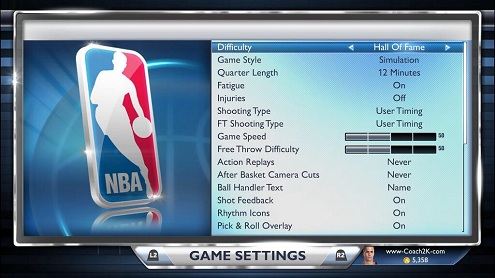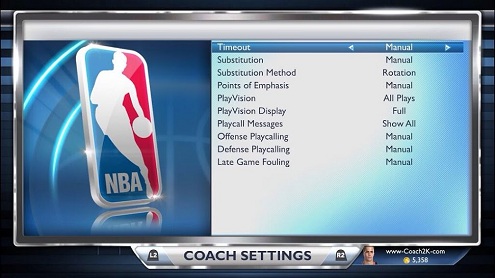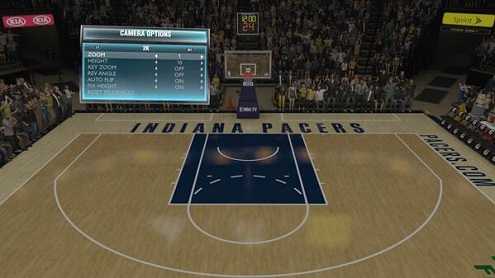My son and I go to a nearby park to practice basketball all of the time. Often when we get there, the goals have been adjusted. Sometimes they are at 8 feet, sometimes 9 feet and sometimes they are even over 10 feet slightly. When we get to the park, we always adjust the goal to 10 feet. We call this process setting up the court to hall of fame difficulty.
It may not seem like a big deal but if my son practiced on an 8 foot goal all of the time, he’s not going to be prepared to shoot on a 10 foot goal in a real game. It’s important for him to prepare for real games on the same height goal he will shoot on in a real game.
NBA2K is pretty much the same. If you want to be a hall of fame level player, then you have to practice on those settings. What you want is consistency from mode to mode so that when you play a game, everything is essentially set to 10 feet.
Game Settings
Here are the things I adjust when I get the game for the first time.
-
- Hall of fame difficulty: I set the difficulty level to hall of fame level across all modes. This is most important in free style practice mode. There are shorter windows for getting shot releases correct when you practice on hall of fame versus practicing on rookie. Basically rookie is more forgiving than pro which is more forgiving than all star and so on. While I often play games at a lower difficulty level (often playing on rookie), I always practice in free style mode on hall of fame.
-
- Simulation game style: Debate rages on sliders. Many are in favor of adjusting them although I am not. The reason I don’t like to adjust them is because I want consistency in sliders both offline vs the CPU and online when I play other users. I don’t want to get accustomed to an easier slider set offline and then struggle using a harder slider set online. To me the use of a consistent slider set is like setting the goal to 10 feet. I am aiming for consistency. I also feel that once I change the sliders, if I make them easier, it’s not really hall of fame difficulty anymore. I would encourage you to set the sliders to simulation and forget it because you will eventually adjust your on court decision making to the simulation slider set. The argument for revised slider sets is one based on getting realistic stats. In my mind that can be accomplished in two ways, one is forcing the game to create it and another is to obtain it through play making. I have found that once you get to know your team and your opponent, you can get to the point where realistic stats can be obtained through your play. Although this doesn’t help get realistic stats for simulated games.
-
- 12 minute quarter length: I recommend that you work your way towards 12 minute quarters. I originally started at 5 minute quarters when I got my first hall of fame win. But in that win, I didn’t have to really sub, deal with foul trouble or fatigue. These are all factors you should have to deal with and playing a full 12 minute quarter game brings all of those factors in.
-
- Fatigue: I set fatigue to on because I want guys to get tired when they play.
-
- Injuries: I set injuries to off (yet they still happen).
-
- Shooting type user timing: I always set my shot timing to user timing and not real field goal percentage. I do this because with real field goal percentage, you only have to make sure you get good shots, where with shot timing, you have to get good shots PLUS get the timing of the shot correct. To me, this makes every player unique and is a harder setting and that’s why I use it.
-
- Game speed: I leave untouched at 50.
- Shot feedback, rhythm icons, pick and roll overlay: I turn all of these on to help me see what is going on with the players on the floor.
Coach Settings
As far as coach settings, you can have success running these completely on auto versus the hall of fame CPU. Often, you’ll find the need to change a few of them.
Here’s a breakdown of what I do:
-
- Timeout: I prefer on manual especially versus other users as I don’t mind playing guys tired. I’ll often just leave to auto. I grew up in the shadow of Bob Knight at Indiana University who didn’t believe in calling timeouts to stop momentum. Because of that I don’t either.
-
- Substitution: While it’s possible that it will work fine on auto, more often than not, you’ll find that the CPU coach will make stupid substitutions. I’ve seen Luis Scola put in at the shooting guard spot before. You’ll have to get to the point where you manage your rotations.
-
- Points of emphasis: I’m mixed on the importance of using auto or manual points of emphasis. I’ve won at a hall of fame level by using both methods. Like auto subs, the CPU coach can mess things up.
-
- Playvision: I set to all plays.
-
- Playvision display: I set to full.
-
- Playcall messages: I set to show all.
- Offense playcalling, defense playcalling and late game fouling: I set all of these to manual. It is sometimes important to set the late game fouling to auto if you want to make sure you foul quickly. Many times though, the CPU will foul in situations where I might not decide to.
The Camera Angle
I always use the same camera view in every mode I play. I would recommend this as well. This will help you have the same view on all shot releases.
I prefer the 2K view when I play, but many good players I know play on broadcast. It’s more important to use the same view across all modes that you prefer than to use the view that I do.
Finally, A Word About Customized Rosters
There are some good roster sets out there. And often the game plays better with those rosters. I’m not opposed to using customized rosters (nor sliders for that matter), except for the sake of consistency. While I might prefer a customized roster, since it’s different from the one I would have to use online if I play other users, it’s an adjustment I don’t want to have to make. For that reason, I use the official NBA2K rosters for all hall of fame game play.
What I’m after is a consistent, hall of fame level set up across every game mode and one you should strive for as well since you should want to represent your team both online versus users and offline versus the CPU.




